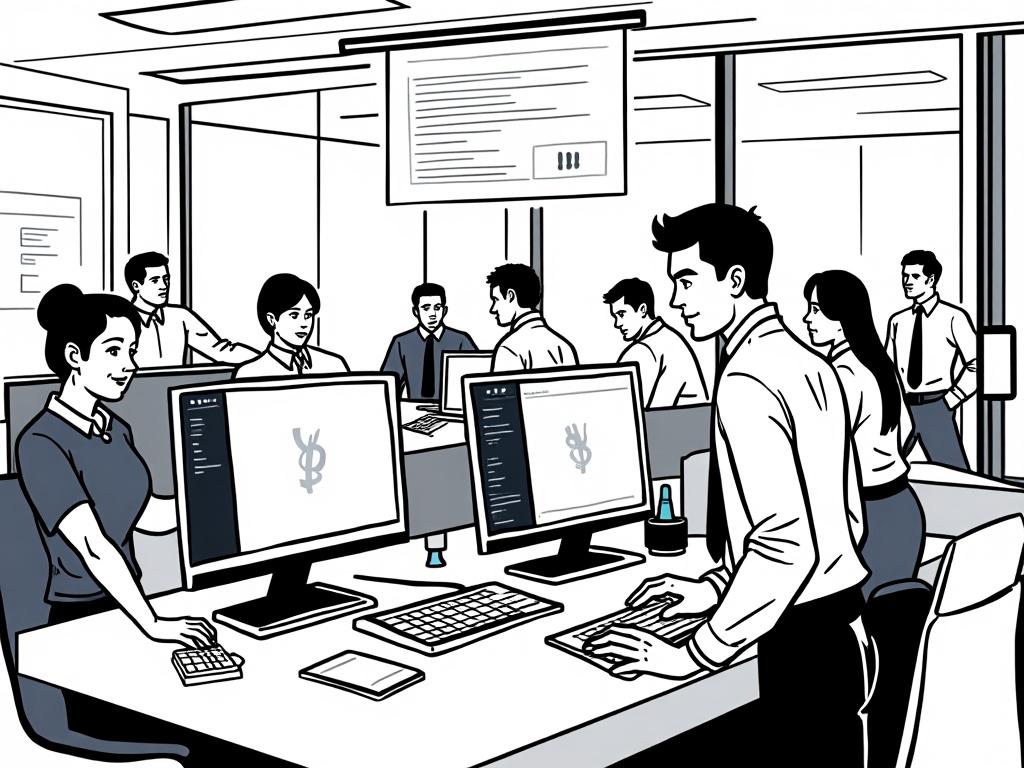
Stock Market Simulators and Paper Trading: Practice Before Investing
Reading time: 12 minutes
Ever stared at a stock chart feeling like you’re deciphering ancient hieroglyphics? You’re not alone. Before risking your hard-earned money, smart investors use simulators to hone their skills. Let’s explore how paper trading can transform you from nervous novice to confident investor.
Table of Contents
- What is Paper Trading?
- Benefits of Stock Market Simulation
- Top Paper Trading Platforms
- Maximizing Your Practice Experience
- Common Pitfalls to Avoid
- Transitioning to Real Money Trading
- Your Trading Success Roadmap
- Frequently Asked Questions
What is Paper Trading?
Paper trading, also known as virtual trading or stock market simulation, is the practice of buying and selling securities using fake money in a real-time market environment. Think of it as a flight simulator for investors—you get all the experience without the crash landing consequences.
Key Characteristics:
- Real market data and pricing
- Virtual portfolio management
- Risk-free learning environment
- Performance tracking and analytics
The concept originated decades ago when traders literally used paper and pencil to track hypothetical trades. Today’s digital platforms offer sophisticated tools that mirror actual trading conditions, complete with real-time quotes, advanced charting, and portfolio analysis.
Benefits of Stock Market Simulation
Well, here’s the straight talk: Paper trading isn’t just for beginners—even seasoned professionals use simulators to test new strategies without financial risk.
Learning Without Financial Pressure
Research from the Financial Industry Regulatory Authority (FINRA) shows that 80% of day traders lose money in their first year. Paper trading helps you avoid becoming part of this statistic by allowing you to make mistakes with virtual money.
Case Study: Sarah, a marketing executive, spent six months paper trading before investing real money. Her virtual portfolio initially lost 15% as she learned to control emotional decisions. When she transitioned to real trading, she achieved a 12% annual return in her first year—significantly outperforming the 90% of new traders who lose money.
Strategy Testing and Refinement
Professional traders regularly use simulators to backtest strategies. According to a 2023 study by Trading Psychology Edge, traders who spent at least three months paper trading before investing real money showed 23% better performance in their first year compared to those who jumped straight into live trading.
Platform Familiarization
Different brokerages offer varying interfaces and tools. Paper trading lets you explore these platforms without commitment, helping you choose the right fit for your trading style.
Top Paper Trading Platforms
Let’s compare the leading paper trading platforms to help you choose the right training ground:
| Platform | Starting Capital | Key Features | Best For | Cost |
|---|---|---|---|---|
| TD Ameritrade thinkorswim | $100,000 | Advanced charting, options trading | Serious traders | Free |
| E*TRADE | $100,000 | User-friendly interface, research tools | Beginners to intermediate | Free |
| TradingView | $100,000 | Social trading, advanced charts | Technical analysts | Free/Premium |
| Investopedia Simulator | $100,000 | Educational content, competitions | Complete beginners | Free |
| Interactive Brokers | $1,000,000 | Professional tools, global markets | Advanced traders | Free |
Platform Success Rates Comparison
Based on user performance data from 2023, here’s how different platforms correlate with trading success:
Platform User Success Rates (% of users profitable after 6 months)
Maximizing Your Practice Experience
Quick Scenario: Imagine you’re about to invest $10,000 of your savings. Would you rather learn expensive lessons with real money or free lessons with virtual funds? The choice seems obvious, yet many skip this crucial step.
Setting Realistic Goals
Don’t treat paper trading like a video game. Set specific, measurable objectives:
- Performance targets: Aim for consistent monthly returns rather than home runs
- Risk management: Never risk more than 2% of your portfolio on a single trade
- Strategy focus: Master one approach before diversifying
Emotional Discipline Training
The biggest challenge isn’t technical analysis—it’s managing emotions. Paper trading helps you recognize patterns in your decision-making. Dr. Brett Steenbarger, trading psychologist, notes: “The trader who can maintain discipline with virtual money has a significantly higher probability of success with real capital.”
Practical Exercise: Keep a trading journal documenting not just what you traded, but why you made each decision and how you felt before, during, and after each trade.
Realistic Scenario Simulation
Many paper traders make unrealistic trades they’d never execute with real money. Combat this by:
- Using smaller position sizes that reflect your actual budget
- Including transaction costs in your calculations
- Setting stop-losses and taking profits at levels you’d actually use
Common Pitfalls to Avoid
The “Monopoly Money” Syndrome
Without real financial consequences, many paper traders take excessive risks they’d never consider with actual money. This creates false confidence and poor habits.
Solution: Treat virtual money as if it’s real. Set strict rules and stick to them religiously.
Ignoring Market Conditions
Bull markets make everyone look like a genius. If you start paper trading during a strong uptrend, you might develop overconfidence. Ensure your practice spans different market conditions or study historical scenarios.
Case Study: Mark began paper trading in March 2020, right at the market bottom. His virtual portfolio soared 40% in six months. When he transitioned to real money in late 2021, the market turned volatile, and his actual performance was flat. He hadn’t prepared for choppy conditions.
Analysis Paralysis
Some traders get stuck in perpetual practice mode, afraid to risk real money. While preparation is crucial, excessive hesitation can be equally detrimental.
Transitioning to Real Money Trading
Ready to transform complexity into competitive advantage? The transition from paper to live trading requires strategic planning.
Performance Benchmarks
Before risking real capital, ensure you’ve achieved:
- Consistent profitability: At least three consecutive profitable months
- Risk management: Maximum drawdown under 10%
- Strategy clarity: Well-defined entry and exit rules
Starting Small
Begin with a fraction of your intended investment. Many successful traders start with just $1,000-$5,000 to test their skills with real market pressure.
Pro Tip: The right preparation isn’t just about avoiding problems—it’s about creating scalable, resilient investment foundations.
Psychological Preparation
Real money trading introduces psychological pressures absent in simulation. Expect initial performance drops as you adjust to genuine financial risk. Studies show most traders experience a 15-25% performance decrease when transitioning from paper to live trading.
Your Trading Success Roadmap
Here’s your strategic action plan for mastering paper trading and transitioning to profitable real-money investing:
Phase 1: Foundation Building (Weeks 1-4)
- Choose a paper trading platform that matches your serious investing goals
- Complete platform tutorials and explore all available tools
- Define your investment strategy focus (value, growth, technical analysis)
- Establish strict position sizing rules (maximum 5% per trade)
Phase 2: Skill Development (Weeks 5-12)
- Execute at least 20 trades following your defined strategy
- Maintain detailed trading journal with entry/exit rationale
- Analyze both winning and losing trades weekly
- Achieve three consecutive profitable months before advancing
Phase 3: Live Market Transition (Weeks 13-16)
- Start with 25% of your intended investment capital
- Execute identical strategies used in paper trading
- Monitor emotional responses and adjust position sizes accordingly
- Gradually increase investment amounts as confidence builds
The convergence of technology and behavioral finance is making paper trading more sophisticated. Advanced platforms now incorporate AI-driven market scenarios and psychological pressure simulations, better preparing traders for real-world conditions.
Your next move matters: Will you join the 80% who lose money by diving in unprepared, or the 20% who succeed through methodical practice? The choice—and the paper trading platform—awaits your decision. What specific investment strategy will you master first in your virtual portfolio?
Frequently Asked Questions
How long should I paper trade before using real money?
Most successful traders recommend 3-6 months of consistent paper trading. Focus on achieving at least three consecutive profitable months with your strategy before transitioning. The key isn’t time—it’s demonstrating consistent profitability and risk management skills.
Do paper trading results accurately predict real trading performance?
Paper trading provides valuable skill development, but real money introduces psychological pressures that can impact performance. Expect a 15-25% initial performance drop when transitioning. However, traders who paper trade extensively typically recover faster and achieve better long-term results than those who skip this preparation.
Which paper trading platform should beginners choose?
For complete beginners, Investopedia’s Stock Simulator offers excellent educational resources alongside the trading experience. As you advance, consider TD Ameritrade’s thinkorswim for its professional-grade tools. Choose based on your learning style: educational content focus (Investopedia) or advanced functionality (thinkorswim, Interactive Brokers).

Article reviewed by Jean Dupont, Institutional Investment Advisor | ESG & Impact Investing Pioneer | Aligning Profit with Purpose for Pension Funds, on July 3, 2025





